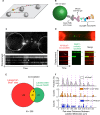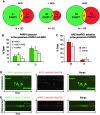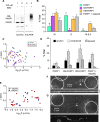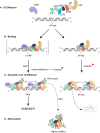PARP1 changes from three-dimensional DNA damage searching to one-dimensional diffusion after auto-PARylation or in the presence of APE1
- PMID: 29121337
- PMCID: PMC5728402
- DOI: 10.1093/nar/gkx1047
PARP1 changes from three-dimensional DNA damage searching to one-dimensional diffusion after auto-PARylation or in the presence of APE1
Abstract
PARP1-dependent poly-ADP-ribosylation (PARylation) participates in the repair of many forms of DNA damage. Here, we used atomic force microscopy (AFM) and single molecule fluorescence microscopy to examine the interactions of PARP1 with common DNA repair intermediates. AFM volume analysis indicates that PARP1 binds to DNA at nicks, abasic (AP) sites, and ends as a monomer. Single molecule DNA tightrope assays were used to follow the real-time dynamic behavior of PARP1 in the absence and presence of AP endonuclease (APE1) on AP DNA damage arrays. These experiments revealed that PARP1 conducted damage search mostly through 3D diffusion. Co-localization of APE1 with PARP1 on DNA was found capable of inducing 1D diffusion of otherwise nonmotile PARP1, while excess APE1 also facilitated the dissociation of DNA-bound PARP1. Moreover, auto-PARylation of PARP1 allowed the protein to switch its damage search strategy by causing a 3-fold increase in linear diffusion. Finally, we demonstrated that PARP inhibitor olaparib did not significantly alter the rate of PARP1 dissociation from DNA, but instead resulted in more motility of DNA-bound PARP1 molecules.
© The Author(s) 2017. Published by Oxford University Press on behalf of Nucleic Acids Research.
Figures






Similar articles
-
Human apurinic/apyrimidinic endonuclease 1 is modified in vitro by poly(ADP-ribose) polymerase 1 under control of the structure of damaged DNA.Biochimie. 2020 Jan;168:144-155. doi: 10.1016/j.biochi.2019.10.011. Epub 2019 Oct 24. Biochimie. 2020. PMID: 31668992
-
Interaction of poly(ADP-ribose) polymerase 1 with apurinic/apyrimidinic sites within clustered DNA damage.Biochemistry (Mosc). 2011 Jan;76(1):147-56. doi: 10.1134/s0006297911010147. Biochemistry (Mosc). 2011. PMID: 21568846
-
Downregulation of APE1 potentiates breast cancer cells to olaparib by inhibiting PARP-1 expression.Breast Cancer Res Treat. 2019 Jul;176(1):109-117. doi: 10.1007/s10549-019-05189-w. Epub 2019 Apr 15. Breast Cancer Res Treat. 2019. PMID: 30989461
-
Poly(ADP-ribosyl)ation by PARP1: reaction mechanism and regulatory proteins.Nucleic Acids Res. 2019 May 7;47(8):3811-3827. doi: 10.1093/nar/gkz120. Nucleic Acids Res. 2019. PMID: 30799503 Free PMC article. Review.
-
[PARP1 inhibitors: contemporary attempts at their use in anticancer therapy and future perspective].Postepy Hig Med Dosw (Online). 2016 Apr 13;70:280-94. doi: 10.5604/17322693.1199303. Postepy Hig Med Dosw (Online). 2016. PMID: 27117104 Review. Polish.
Cited by
-
DNA scanning by base excision repair enzymes and implications for pathway coordination.DNA Repair (Amst). 2018 Nov;71:101-107. doi: 10.1016/j.dnarep.2018.08.013. Epub 2018 Aug 25. DNA Repair (Amst). 2018. PMID: 30181039 Free PMC article. Review.
-
Targeting DNA damage sensors for cancer therapy.DNA Repair (Amst). 2025 May;149:103841. doi: 10.1016/j.dnarep.2025.103841. Epub 2025 May 2. DNA Repair (Amst). 2025. PMID: 40339280 Review.
-
The contribution of PARP1, PARP2 and poly(ADP-ribosyl)ation to base excision repair in the nucleosomal context.Sci Rep. 2021 Mar 1;11(1):4849. doi: 10.1038/s41598-021-84351-1. Sci Rep. 2021. PMID: 33649352 Free PMC article.
-
Single molecule analysis reveals monomeric XPA bends DNA and undergoes episodic linear diffusion during damage search.Nat Commun. 2020 Mar 13;11(1):1356. doi: 10.1038/s41467-020-15168-1. Nat Commun. 2020. PMID: 32170071 Free PMC article.
-
AP-endonuclease 1 sculpts DNA through an anchoring tyrosine residue on the DNA intercalating loop.Nucleic Acids Res. 2020 Jul 27;48(13):7345-7355. doi: 10.1093/nar/gkaa496. Nucleic Acids Res. 2020. PMID: 32542366 Free PMC article.
References
-
- Ame J.C., Spenlehauer C., de Murcia G.. The PARP superfamily. Bioessays. 2004; 26:882–893. - PubMed
-
- Benjamin R.C., Gill D.M.. Poly(ADP-ribose) synthesis in vitro programmed by damaged DNA. A comparison of DNA molecules containing different types of strand breaks. J. Biol. Chem. 1980; 255:10502–10508. - PubMed
-
- Dantzer F., Ame J.C., Schreiber V., Nakamura J., Menissier-de Murcia J., de Murcia G.. Poly(ADP-ribose) polymerase-1 activation during DNA damage and repair. Methods Enzymol. 2006; 409:493–510. - PubMed
-
- Pion E., Ullmann G.M., Ame J.C., Gerard D., de Murcia G., Bombarda E.. DNA-induced dimerization of poly(ADP-ribose) polymerase-1 triggers its activation. Biochemistry. 2005; 44:14670–14681. - PubMed
MeSH terms
Substances
Grants and funding
LinkOut - more resources
Full Text Sources
Other Literature Sources
Molecular Biology Databases
Research Materials
Miscellaneous

